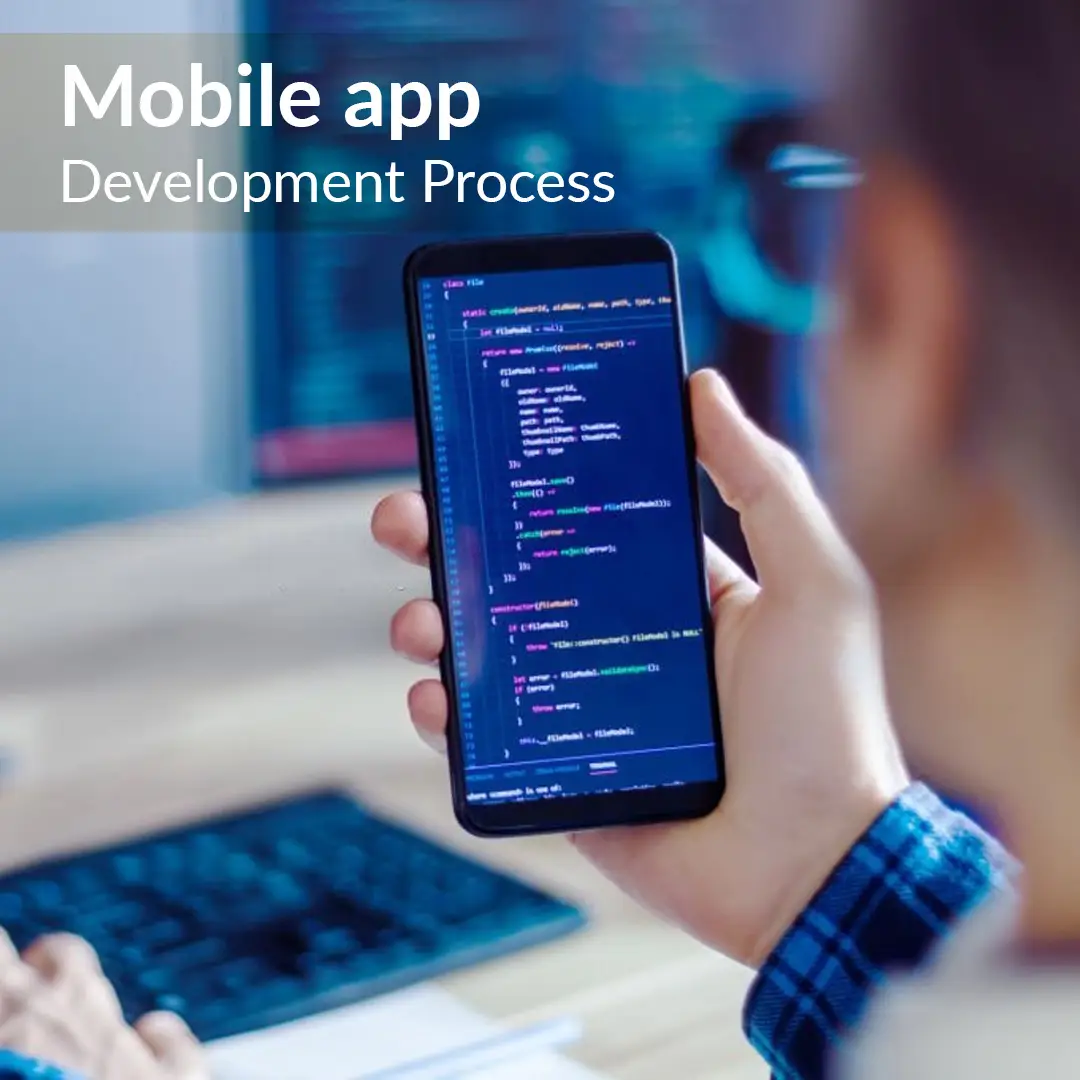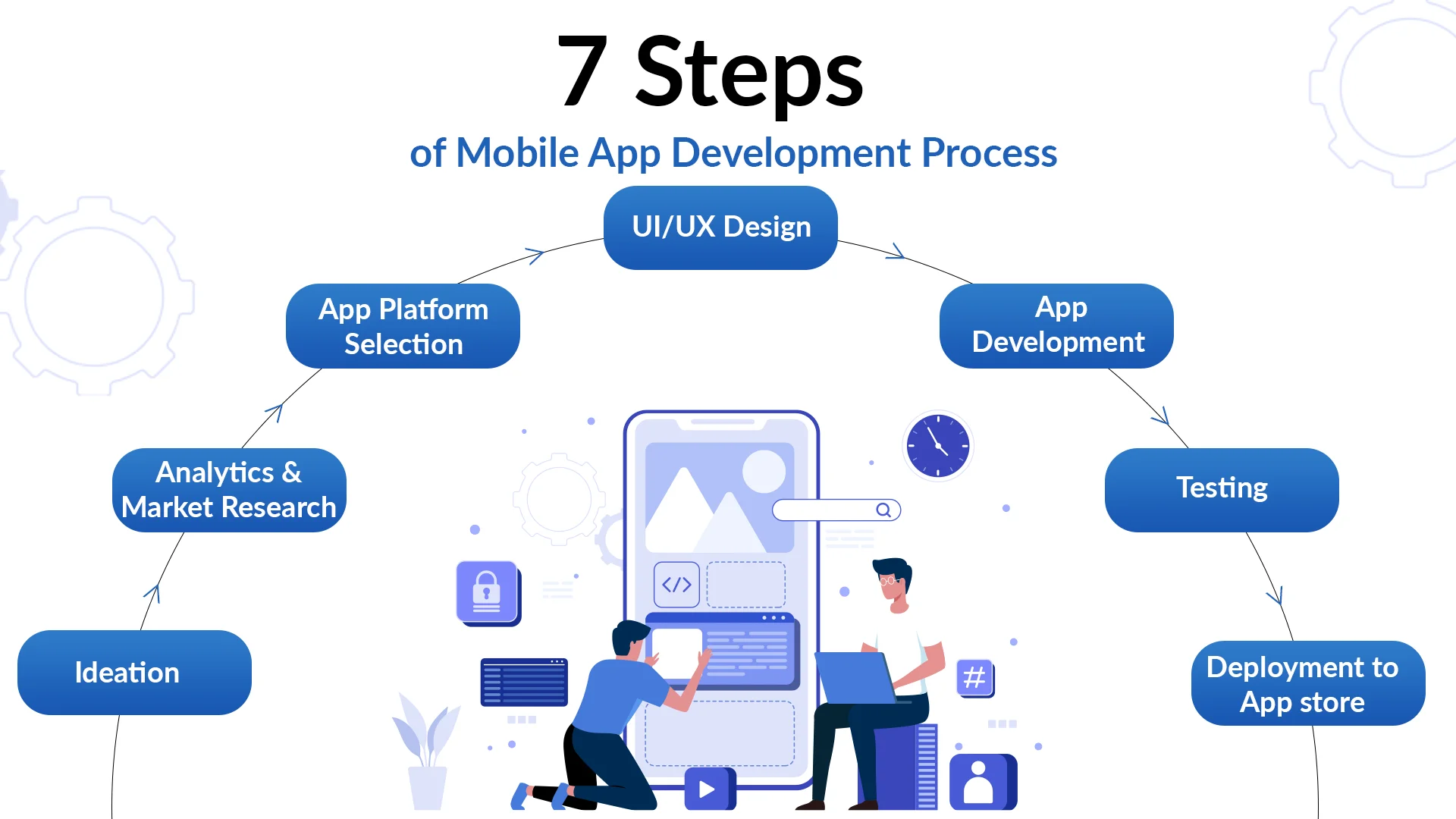A Step-by-Step Guide for Mobile App Development
In an increasingly saturated app market, developers must go beyond simply developing an app and focus on creating a marketable product. Whether developing for iOS or Android, the key is to ensure that users not only download but also continue to use the app, generating revenue. Success lies in capturing user attention, delivering value, and providing a seamless experience that keeps them engaged and satisfied with the app.

“Consumer spending on mobile apps experienced significant growth between 2019 and 2021, reaching $170 billion. Revenue across various industries is expected to continue rising in the coming years, with projections indicating a potential increase to $613 billion by 2025.”– Statista
Why Do You Need a Mobile App for Your Business?
Businesses need mobile apps to stay competitive in the digital age. Mobile apps offer several advantages for businesses:
1. Increased Customer Engagement
Mobile applications work as a direct and convenient channel for customers to interact with your business. By enabling personalized experiences, curated promotional offers, with real-time notifications can contribute significantly to business growth. This seamless communication increases customer satisfaction, cultivates loyalty, and strengthens relationships. Businesses may employ mobile apps to develop a customer-centric ecosystem that delights users, promotes long-term engagement, and establishes a powerful base for long-term success.
2. Increased Sales & Revenue
Mobile apps are powerful tools for boosting sales and enhancing revenue. Businesses can build a seamless transaction experience that encourages repeat business by integrating features like in-app purchases and mobile payments. Utilizing app analytics also enables businesses to learn crucial details about demographics, preferences, and user behavior. Businesses may use this information to help fine-tune and maximize their revenue, so they are both highly targeted and successful.
3. Improved Brand Visibility
Mobile apps serve as a ubiquitous presence on customers’ smartphones, serving as powerful tools to enhance brand awareness. They serve as regular reminders of the business by taking up valuable real estate on users’ devices, promoting brand identification and recall. This widespread brand visibility strengthens the business’s identity, expands its market, and helps to build a solid and enduring brand presence in consumers’ thoughts.
4. Improved Customer Service
Numerous customer service tools are available in mobile apps, such as in-app chat, help requests, and in-depth FAQs, which help to effortlessly speed up support. These powerful functionalities give businesses the ability to respond to customer queries and issues quickly, improving the customer support experience. Businesses improve customer satisfaction, promote loyalty, and build a reputation for providing great service by using mobile apps to deliver quick and effective solutions.
5. Data-Driven Insights
Mobile apps enable businesses to gather valuable data on customer behavior, preferences, and usage patterns, enabling informed decision-making, optimized marketing strategies, and product service enhancement. Businesses get important insights through the analysis of this data that promote innovation, customer satisfaction, and growth. Utilizing mobile app analytics gives businesses, the ability to remain adaptable, customer-focused, and competitive.
7 Steps of Mobile App Development Process
The mobile application development process steps follow a similar structure regardless of how each app differs. It continuously adapts to meet specific app requirements. Here are the methods and steps involved in developing mobile apps:
1. Ideation
Each mobile project begins with its own distinct circumstances. Some customers approach us with a concept, while others provide a list of desired features or specific requirements. In certain cases, customers seek to replicate an existing system, such as when a web-based platform necessitates a seamless cross-device experience through an app for customers or employees. Our primary goal right from the start is to gain a comprehensive understanding of your product idea. We delve into key aspects such as the target audience, target platform(s), existing competition, business objectives, and the potential marketing plan.
To kickstart the mobile app development process, we conduct customer interviews and workshops, engaging various stakeholders such as product owners, designers, marketing teams, and subject matter experts. This collaborative approach allows us to gather comprehensive project information, address your expectations, and gain insights into your company’s context and market dynamics. Through these interactions, we aim to cover project-related details and establish a solid foundation for the development journey. After obtaining the essential data and requirements, we move forward to a critical stage of the mobile app development process: analytics and market research.
2. Analytics & Market Research
In the highly competitive landscape of mobile apps, thorough market research becomes imperative. Understanding competitors, their strengths, weaknesses, and the factors contributing to their success is crucial. A business analyst often conducts this research, identifying competitors, analyzing their products, and assessing customer sentiments. By gaining insights into user preferences through market research, businesses can optimize their app’s features to appeal to a wider customer base.
Following are a few benefits of conducting market research:
- You’re able to better understand your clientele.
- It helps you identify how to connect with your target audience.
- It facilitates a thorough assessment of the products prior to promotion.
Comprehensive market research minimizes the risk of app failure and enables effective cost management.
3. App Platform Selection
We will guide you in choosing the most suitable platform from the available options for the various phases of mobile app development.
- Native Apps – Developers can create native apps for specific platforms such as Android and iOS using programming languages and development tools that are supported by these platforms. They can fully use the capabilities of the respective platforms by using the native development tools and languages, assuring optimal performance and smooth integration with the platform’s features and functionalities.
- Cross-Platform Apps – Cross-platform or hybrid applications are versatile mobile applications that are developed using HTML5 and can be run on multiple platforms. These apps can be downloaded from various app stores, just like native applications. Developers can reach a bigger audience more affordably and effectively by utilizing web technologies to produce a single codebase that can be deployed across several platforms without the requirement for additional platform-specific development activities.
- HTML5 Web Apps – An HTML5 web app is a mobile-optimized website that mimics the look and feel of a native application but runs within a mobile browser. It provides platform independence and ensures interoperability with a range of devices. It offers a greater user experience and functionality despite not being offered in app stores. HTML5 web apps are extremely helpful when there are restrictions on the use of the app store or when consumers might not want to download a certain application. These apps give content and services to a variety of consumers in a simple and accessible way by utilizing the power of web technologies.
4. UI/UX Design
The first impression users have when opening your application is crucial. While features are important, it’s the user’s experience that matters. If users struggle or have a negative experience, they may switch to another app or leave negative reviews. To avoid this, prioritize UI/UX design to ensure a user-friendly and intuitive interface that enhances usability and satisfaction.
- Develop a UX Wireframe – The application’s framework is established through the creation of mobile screen layouts, navigation bars, interactive features, and other interface elements. Wireframes aid in preventing issues and ensuring alignment between information architecture and content structure. Additionally, roadmaps or storyboards illustrate screen relationships and user navigation within the app, facilitating comprehension and validation of the UX team’s design decisions through user testing.
- Create a Style Guide – Style guides are essential “living documents” that define an application’s style requirements throughout its development, covering branding guidelines and navigation icons. When establishing design standards for mobile apps, it is important to consider factors such as appealing colors, interactive graphics, and attractive typography.
- Build a Prototype – To gain a comprehensive understanding of the user experience, it is vital to create a working prototype at the earliest opportunity. By swiftly developing a prototype using simple wireframes, businesses can assess the app’s functionality in common-use scenarios. Involving stakeholders in this process allows for valuable feedback and opportunities for improvement. Granting stakeholders access to the prototype enables the collection of their thoughts and offers them an initial glimpse of the app, aiding in the validation of collected data.
5. App Development
Handing over the finalized and approved UI (User Interface) design to the development team signals the start of the next phase in app development. This transition should be seamless, with designers and developers collaborating closely to iron out details before any coding begins. The development phase, which is the most time-consuming, aims to create a captivating and pixel-perfect application while ensuring its practicality. It is also the most gratifying stage as it allows for hands-on testing and continuous monitoring of the app’s progress, allowing for occasional testing of new iterations.
- Backend Development – Backend development encompasses server-side engineering, and it typically builds upon the initial tech scope established during the initial stages of mobile application development. It involves developing or integrating tools such as content management systems for managing app content, databases for storing and retrieving user data, and working with third-party systems and software, including widgets and APIs (application programming interfaces). In many instances, third-party cloud services are engaged to host and maintain the app’s infrastructure. These backend development activities are tailored to meet the specific technical specifications and functional requirements of the application.
- Frontend Development – In the mobile apps development process, the frontend refers to building the customer application that users will install on their smartphones. This involves implementing the UI design and ensuring its functionality. It is important to consider that the code will be executed on mobile devices with limited memory and battery life. Hence, careful choices need to be made to optimize the app’s performance. For instance, decisions must be made regarding the level of processing to be done directly on the device, aiming for near-instantaneous user response for features like picture editing or smooth offline performance for industrial applications. These considerations ensure an efficient and user-friendly frontend experience.
6. Testing (Quality Assurance)
A major cause of severe failure is the release of a program without prior beta testing. Conducting thorough beta testing allows for valuable feedback from the target audience, enabling app improvement and increased visibility in app stores. Launching a mobile app without beta testing can lead to disastrous outcomes, as its performance in a real-world setting with numerous users remains uncertain. Engaging in rigorous beta testing helps gather insights from the target audience, enhancing app usability and generating visibility in app marketplaces. Employing a trial-and-error approach with trusted individuals aids in this iterative improvement process.
To ensure a robust mobile application, it is crucial to distribute it to a wide user base for comprehensive testing. By soliciting constructive feedback, you can enhance your entire app development process and avoid costly post-launch revisions. Engaging with a diverse set of users allows for the thorough identification of any potential flaws and facilitates continuous improvement, leading to a more polished and successful app.
7. Deployment to App store
Upon reaching the readiness to release your app, you will encounter different distribution approaches based on the targeted platform. For mobile applications, the deployment process typically involves submitting your app to either the Google Play Store or the Apple App Store or opting for private distribution. It is important to note that both stores require app submission and evaluation, along with completing relevant documentation. Notably, the App Store is known for its stringent selection criteria, making it crucial for iOS-based apps to meet exceptional standards to avoid potential issues during the review process.
In the case of private distribution, the Developer Enterprise Programme offered by Apple and the Alternative Distributions available for Android provides viable options to consider. These programs offer alternative pathways for distributing your app outside of the official app stores, allowing greater flexibility in deployment strategies. Exploring these options can help you make an informed decision on the most suitable approach for private distribution based on your specific requirements and preferences.
Ready to Start Your Mobile App Development?
While the mobile app development process may appear daunting with its extensive list of stages and considerations, it certainly becomes easier with a right technology partner. Despite the complexity involved, the potential benefits and opportunities offered by developing a mobile app make it a worthwhile initiative to pursue. When you work with a trusted technology partner who has experience and knows the pitfalls can deliver a better-quality MVP. Careful planning, collaboration, and the right resources, your business can successfully navigate the development journey and reap the rewards of a well-crafted mobile application.
Whether you’re seeking mobile app development for internal purposes or consumer-focused solutions, our team at NextGen Invent is delighted to assist you. With our extensive expertise in developing innovative solutions, we can address challenges and provide exceptional user experiences.
If you’re considering your next mobile initiative, please don’t hesitate to contact us. Our team will promptly respond to your inquiries, offering valuable insights and addressing any concerns you may have.
Stay In the Know
Get Latest updates and industry insights every month.

